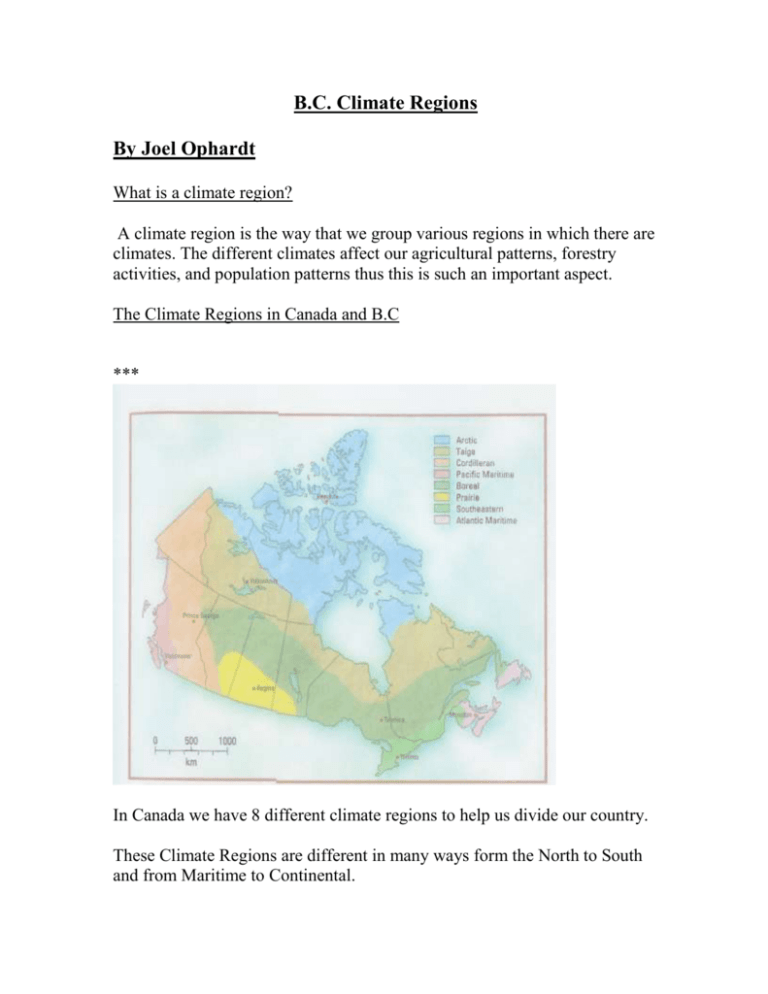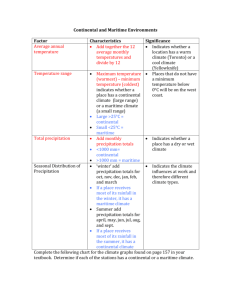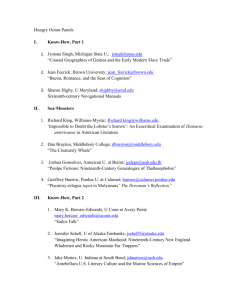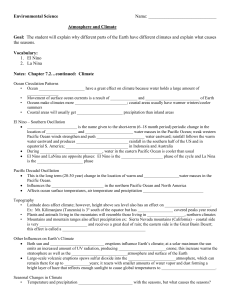B.C._Climates_Ophard..
advertisement

B.C. Climate Regions By Joel Ophardt What is a climate region? A climate region is the way that we group various regions in which there are climates. The different climates affect our agricultural patterns, forestry activities, and population patterns thus this is such an important aspect. The Climate Regions in Canada and B.C *** In Canada we have 8 different climate regions to help us divide our country. These Climate Regions are different in many ways form the North to South and from Maritime to Continental. **** In B.C we have four different Climate Regions: Taiga Boreal and the two main ones Pacific Maritime and Cordilleran. The Pacific Maritime: The Pacific Maritime is located on the entire western seaboard of B.C.. The Pacific Maritime has a very moderate climate. The moderating affect of water keeps this regions temperature range very primitive. The temperature does not reach very high or low temperatures. The average temperature should be higher in the Pacific Maritime than the Atlantic Maritime because the Pacific Ocean carries a warm current from Asia into the coast of B.C. to keep the climate significantly warmer all year round. There is heavy rainfall in the Pacific Maritime Climate region, which is again the fault of the Ocean. The Precipitation in All regions is above 1000 mm and in some regions we have rainforest. This region is thus very vulnerable to leaching and as a result most vegetation are trees, as the plants cannot reach humus. The climate allows for mainly coniferous and some mixed forests. **** This is an example of the Pacific climate in Vancouver B.C. QuickTime™ and a TIFF (Uncompressed) decompressor are needed to see this picture. The Cordilleran region: The Cordilleran region in B.C. is located from the Centre of B.C. to most of the entire eastern side and it stretches from north to south. This region is much like the Pacific Maritime Region. The adjustments that are made are that the precipitation is slightly lower in certain areas and the temperature ranges slightly more. However this is not all to this region, the Cordilleran region obviously contains the Rocky Mountains, which complicates this area a little more. The above stated material still is true when you are located in front of the mountains and not on top our behind. When one is on this mountain it is obviously colder and when one is at the bottom the temperature is normal again, which means that it is still slightly moderated by the ocean and slightly warmed by the warm ocean current. The difference in Temperature in the B.C. area creates two different kinds of vegetation there: tundra and coniferous. The precipitation has it much more difficult that the temperature. When the warm air is carried in from the Pacific Ocean a climate factor called relief precipitation is started. The warm air rises up the steep mountains from the Cordilleran region and since they are full of moist air from the ocean when the air rises it cools and as it cools it condenses, or rains, on the top of the mountain because the cold air can no longer hold the moisture. This creates a void area of rain in the spaces in between the two mountain ranges in this region. As a result there is a different amount of precipitation in the Cordilleran Region. **** Here is an example of the Cordilleran climate in Kamloops QuickTime™ and a TIFF (Uncompressed) decompressor are needed to see this picture. The Taiga and Boreal: These two regions only make up a very small part of B.C.. These regions are located in north eastern corner of B.C.. The Taiga is on top of the Boreal. The Boreal region in B.C. has a high range in temperature and a fair average temperature. Normally this region has a fair amount of precipitation, but since it is following the Rocky Mountains it has slightly less rainfall in B.C. than in the other parts of the Boreal Region. The type of trees in this location is called Coniferous. The Taiga region has an average temperature range and a very low average temperature. This region also receives very little rain. Overall: B.C., compared to other provinces has a very big range in climates. The climate ranges from cold to hot, high rainfall to medium rainfall to very little rainfall, and from coniferous to tundra (which are a result of climate). No other province has this amount of Climate regions. The Ocean, Ocean Current, Mountains/Relief precipitation, and Latitude are all the factors that contribute to the vast majority of this diverse climate. *** the photo’s are scans of Joel Ophardt of the Making Connection, Canada’s Geography Gr. 9 textbook. **** These Graphs are taken from http://www.canadainfolink.ca/climateWESTERN.htm





